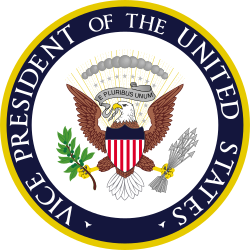Hubert Humphrey
| Den här artikeln behöver källhänvisningar för att kunna verifieras. (2013-04) Åtgärda genom att lägga till pålitliga källor (gärna som fotnoter). Uppgifter utan källhänvisning kan ifrågasättas och tas bort utan att det behöver diskuteras på diskussionssidan. |
| Hubert H. Humphrey | |
 | |
USA:s 38:e vicepresident | |
| Tid i befattningen 20 januari 1965–20 januari 1969 | |
| President | Lyndon B. Johnson |
|---|---|
| Företrädare | Lyndon B. Johnson |
| Efterträdare | Spiro Agnew |
| Född | 27 maj 1911 Wallace i Codington County, South Dakota, USA |
| Död | 13 januari 1978 (66 år) Waverly, Minnesota |
| Gravplats | Lakewood Cemetery |
| Politiskt parti | Demokraterna |
| Yrke | Apotekare |
| Maka | Muriel Fay Buck |
| Namnteckning | |
Hubert Horatio Humphrey II, född 27 maj 1911 i Wallace i Codington County, South Dakota, död 13 januari 1978 i Waverly, Minnesota, var en amerikansk politiker. Han var den 38:e vicepresidenten i USA, under Lyndon B. Johnson, 1965–1969. Han var också borgmästare i Minneapolis samt senator för delstaten Minnesota 1949–1964 och 1971–1978.
Biografi
Humphrey försökte bli Demokratiska partiets presidentkandidat i valen 1952 och 1960, och vicepresidentkandidat 1956, men blev inte nominerad. Efter att han tjänstgjort som Lyndon Johnsons vicepresident, blev han nominerad till demokraternas presidentkandidat i valet 1968; Johnson själv ställde inte upp på grund av den stora impopularitet han fått utstå på grund av det pågående Vietnamkriget. Humphrey förlorade dock mot republikanen Richard Nixon med en hårfin marginal. Nederlaget berodde delvis på grund av att Humphreys rykte, trots sin stora popularitet i sociala frågor, också fick lida då den demokratiska administrationen fått möta hård kritik för engagemanget i Vietnamkriget och den ekonomiska och sociala kris som plågat USA. Nixons program byggde till stor del på en vision om framtidsoptimism – en ny start för Amerika – och en populistisk kritik av Johnson och Kennedys engagemang i Vietnam, samtidigt som han med populistisk retorik kallade till försvar av den nationella stoltheten. USA skulle inte förödmjukas av Vietnam, kosta vad det kosta ville.
Ursprungligen var han utbildad till apotekare. Han gjorde ett flertal besök i Sverige.
Han är berömd för ett tal vid demokraternas konvent i Philadelphia 1948, där han sade till partiledamöterna:
| ” | To those who say, my friends, to those who say, that we are rushing this issue of civil rights, I say to them we are 172 years too late! To those who say, this civil rights program is an infringement on states' rights, I say this: the time has arrived in America for the Democratic Party to get out of the shadow of states' rights and walk forthrightly into the bright sunshine of human rights! | „ |
| – Hubert Humphrey, 1948 | ||
Humphrey och den liberala fraktionen var framgångsrika vid konventet, och det demokratiska partiet antog en skarpare programpunkt vad gällde medborgerliga rättigheter för svarta. Det ledde till att konservativa demokrater från Sydstaterna bröt sig ur partiet och bildade States' Rights Democratic Party (Dixiecrats), med Strom Thurmond som partiledare, som också ställde upp i presidentvalet samma år.
Efter presidentvalet 1968 gjorde Humphrey comeback inom politiken då han valdes till senator för Minnesota 1970. Han gjorde ett nytt försök inför 1972 års presidentval att bli nominerad till demokraternas presidentkandidat men misslyckades.
Humphrey avled i cancer den 13 januari 1978 i sitt hem i Waverly, Minnesota, 66 år gammal.
Byggnader namngivna efter Humphrey
- Humphreyterminalen på Minneapolis-Saint Paul International Airport
- Sportarenan Hubert H. Humphrey Metrodome i Minneapolis, Minnesota
- Hubert H. Humphrey Institute of Public Affairs på University of Minnesota
Externa länkar
- Amerikanska kongressens biografi över Humphrey
- ”University of Texas biografi över Humphrey”. Arkiverad från originalet den 19 november 2000. https://web.archive.org/web/20001119021400/http://www.lbjlib.utexas.edu/johnson/archives.hom/FAQs/humphrey/HHH_home.asp.
- ”When All the Experts Got It Wrong: Harry Truman's Upset Presidential Victory, 1948”. Arkiverad från originalet den 19 januari 2012. https://web.archive.org/web/20120129153326/http://www.austincc.edu/lpatrick/his1302/WhenAllTheExperts1.html. - artikel som handlar om demokraternas konvent och presidentvalet 1948.
| |||||||||||||||||||||||
| ||||||||||
|
Media som används på denna webbplats
Författare/Upphovsman: Tkgd2007, Licens: CC BY-SA 3.0
A new incarnation of Image:Question_book-3.svg, which was uploaded by user AzaToth. This file is available on the English version of Wikipedia under the filename en:Image:Question book-new.svg
Seal of the Vice President of the United States. The blazon is defined in Executive Order 11884 as:
The design is the same as the Seal of the President of the United States, except that there is no ring of stars, the clouds are gray (instead of proper), the stars are gray (instead of argent), the scroll is gray (instead of white), the arrows are gray (instead of proper), and the background colors and inscription (obviously) differ.The Coat of Arms of the Vice President of the United States shall be of the following design:
SHIELD: Paleways of thirteen pieces argent and gules, a chief azure; upon the breast of an American eagle displayed holding in his dexter talon an olive branch proper and in his sinister a bundle of thirteen arrows gray, and in his beak a gray scroll inscribed "E PLURIBUS UNUM" sable.
CREST: Behind and above the eagle a radiating glory or, on which appears an arc of thirteen cloud puffs gray, and a constellation of thirteen mullets gray.
The Seal of the Vice President of the United States shall consist of the Coat of Arms encircled by the words "Vice President of the United States."
Cropped "Official Photograph" of Hubert H. Humphrey as Vice President of the United States of America
Hubert H. Humphrey's signature.





